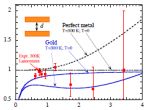EPJ D Highlight - Plasma: Casimir and Yukawa mesons
- Details
- Published on 29 October 2014

The Casimir electromagnetic fluctuation forces across plasmas are analogous to so-called weak nuclear interaction forces, as new findings show
A new theoretical work establishes a long-sought-after connection between nuclear particles and electromagnetic theories. Its findings suggests that there is an equivalence between generalised Casimir forces and what are referred to as weak nuclear interactions between protons and neutrons. The Casimir forces are due to the quantisation of electromagnetic fluctuations in vacuum, while the weak nuclear interactions are mediated by subatomic scale particles, originally called mesons by Yukawa. These findings by Barry Ninham from the Australian National University, in Canberra, and European colleagues, have now been published in EPJ D.The study focuses on two perfectly reflecting model plates, separated by any non-zero density plasma—i.e., a charged gas which may contain electrons only or electrons and positrons. The authors extended the formulae for the Casimir force between these ideal metal plates to include interactions across a plasma and temperature, explicitly.
The ensuing formulae show that long-range electromagnetic fluctuations are qualitatively different from those across a vacuum. They also shed some new light on measurements of Casimir forces between metal plates, an issue that has long puzzled physicists.
In addition, the authors revisited and reworked the formulae for the original Casimir force across a vacuum to correctly account for the temperature. At extremely small distances—also tantamount to very high temperatures—the formulae are equivalent to the effect of the force of an electron-positron plasma in the space between the interacting ideal plates, according to the study.
In this context, the mesons of the nuclear interaction theory become plasmons, which are collective excitations in the sea of electron-positron pairs in the vacuum. If the correspondence proves correct, the implications are profound for broad areas ranging from physical chemistry to nanotechnology.
B. W. Ninham, M. Boström, C. Persson, I. Brevik, S. Y. Buhmann, and B. E. Sernelius (2014), Casimir Forces in a Plasma: Possible Connections to Yukawa Potentials, European Physical Journal D, DOI: 10.1140/epjd/e2014-50484-8




